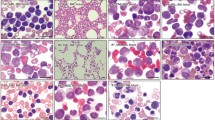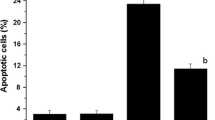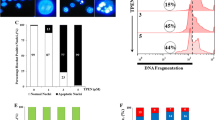Abstract
Carboplatin (CP), a second generation platinum compound, is effective against various types of cancers, producing less nephrotoxicity and ototoxicity but more myelotoxicity than cisplatinum. CP-myelosuppression is the rate-limiting step of its clinical use. Prevention of CP-myelosuppression is a major target in the field of chemotherapy. Therefore, the present study investigates the use of L-carnitine (LCR)—an antioxidant, cardioprotective, neuroprotective, and immunostimulant nontoxic natural compound—to protect against CP-induced myelosuppression. The viability of BMC was studied using a trypan blue exclusion technique following incubation with CP and/or LCR as a function of time and concentration. Apoptosis was tested for by detecting the amount of DNA fragmentation and the visualization of DNA ladders upon gel electrophoresis. Bone marrow progenitor cell function was examined by colony forming unit assay. Cellular contents of glutathione (GSH) and malondialdehyde (MDA) were also estimated. Results revealed that LC50 of CP is 4.7 mM and the highest safe concentration of LCR is 5 mM. Co-exposure of LCR+CP rescued BMC viability by 37% compared to the CP-treated cultures. The LCR halts CP-induced apoptosis and it significantly improves the function of the bone marrow progenitors by increasing the number of colony-forming units as a response to granulocyte/macrophage colony stimulating factors. Finally, LCR restores CP-induced GSH depletion and prevents MDA elevation in BMC. In summary, the results suggest that LCR is able to protect against CP-induced myelosuppression, which suggests its use as an adjuvant therapy. This finding merits further investigation into the mechanism(s) of such protection as well as its interaction with CP antitumor activity.










Similar content being viewed by others
References
Alberts DS, Peng YM, Moon TE, Bressler R (1978) Carnitine prevention of adriamycin toxicity in mice. Biomedicine 29(8):265–268
Alesci De, Martino Mu Mirani M, Benvenga S, Trimarchi F, Kino T, Chrousos GP (2003) L-carnitine: a nutritional modulator of glucocorticoid receptor functions. FASEB J 17(11):1553–1555
Andrieu-Abadie N, Jaffrezou JP, Hatem S, Laurent G, Levade T, Mercaider JJ (1999) L-carnitine prevents doxorubicin-induced apoptosis of cardiac myocytes: role of inhibition of ceramide generation. FASEB J 13(12):1501–1510
Antman KH (2000) High-dose chemotherapy in breast cancer: the end of the beginning. Biol Blood Marrow Transplant 6:469–475
Arafa MM, Sayed-Ahmed M (2003) Protective role of carnitine esters against alcohol-induced gastric lesions in rats. Pharmacol Res 48(3):283–290
Arafa HM, Abd-Allah AR, El-Mahdy MA, Ramadan LA, Hamada FM (2003) Immunomodulatory effects of L-carnitine and Q10 in mouse spleen exposed to low-freqency high-intensity magnetic field. Toxicology 187(2–3):171–181
Arockia-Rani PJ, Panneerselvam C (2001) Carnitine as a free radical scavenger in aging. Exp Gerontol 36(10):1713–1726
Athanassakis I, Mouratidou M, Sakka P, Evangeliou A, Spilioti M, Vassiliadis S (2001) L-carnitine modifies the humoral immune response in mice after in vitro or in vivo treatment. Int Immunopharmacol 1(9–10):1813–1822
Atroshi F, Biese I, Saloniemi H, Ali-Vehmas T, Saari S, Rizzo A, Veijalainen P (2000) Significance of apoptosis and its relationship to antioxidants after ochratoxin A administration in mice. J Pharm Pharm Sci 3(3):281–291
Burton K (1956) A study of the conditions and mechanism of the diphenylamine reaction for colorimetric estimation of deoxyribonucleic acid. Biochem J 62:315–318
Forloni G, Angeretti N, Smiroldo S (1994) Neuroprotective activity of acetyl-L-carnitine: studies in vitro. J Neurosci Res 37(1):92–96
Hagen TM, Liu J, Lykkesfeldt T, Wehrt CM, Ingersoll R, Vinarsky V, Bartholomew JC, Ames BN (2002) Feeding acetyl-L-carnitine and lipoic acid to old rats significantly improves metabolic function while decreasing oxidative stress. Proc Natl Acad Sci USA 99(4):1870–1875
Hassan MI, Ahmed MI, Kassim SK, Rashad A, Khalifa A (1999) Cis-platinum-induced immunosuppression: relation to melatonin in human peripheral blood mononuclear cells. Clin Biochem 32(8):621–626
Huitema ADR, Spaanders M, Mathot RAA, Tibben MM, Holtkamp MJ, Beijnen JH, Rodenhnis S (2002) Relationship between exposure and toxicity in high-dose chemotherapy with cyclophosphamide, thiotepa and carboplatin. Ann Oncol 13:374–384
Inoue M, Sato EF, Nishikawa M, Park AM, Kira Y, Imada I, Utsumi K (2003) Cross talk of nitric oxide, oxygen radicals, and superoxide dismutase regulates the energy metabolism and cell death and determines the fates of aerobic life. Antioxid Redox Signal 5(4):475–484
Kanzawa F, Koizumi F, Kog Y, Nakamura T, Tatasumi Y, Fukomoto H, Saijo N, Yoshioka T, Nishio K (2001) In vitro synergistic interaction between the cisplatin analogue nedaptin and DNA topoisomerase 1 inhibitor irinotecan and the mechanism of this interaction. Clin Cancer Res 7:202–229
Karlic H, Lohninger A, Laschan C, Alexander L, Bohmer F, Huemer M, Guthann E, Rapdold E, Pfeilstocher M (2003) Down regulation of carnitine acyltransferase and organic cation transport OCTN2 in mononuclear cells in healthy elderly and patients with myelodysplastic syndrome. J Mol Med 81(7):435–442
Kiziltunc A, Cogalgil S, Cerrahoglu L (1998) Carnitine and antioxidants levels in patients with rheumatoid arthritis. Scand J Rheumatol 27(6):441–445
Kobayashi K, Kudoh S, Takemoto T, Hino M, Hayashihara K, Nakahiro K, Ando M, Niitani H (1995) In vitro investigation of a combination of two drugs, cisplatin and carboplatin, as a function of the area under the c/t curve. J Cancer Res Clin Oncol 121(12):715–720
Lotem J, Peled-Kamara M, Groner Y, Sachs L (1996) Cellular oxidative stress and control of apoptosis by wild-type p53, cytotoxic compounds and cytokines. Proc Natl Acad Sci USA 93:9166–9171
Mabro M, Faivre S, Raymond E (1999) A risk-benefit assessment of amifostine in cytoprotection. Drug Saf 21(5):367–387 (Review)
Maestroni GJ, Togni M, Covacci V (1997) Norepinephrine protects mice from acute lethal doses of carboplatin. Exp Hematol 25(6):491–494
Masse A, Ramirez LH, Bindoula G, Grillon C, Wdzieczak-Bakala J, Raddassi J, Deschamps de Paillette E, Mencia-Huerta JM, Koscielny S, Potier P, Sainteny F, Carde P (1998) The tetrapeptide acetyl-N-Ser-Asp-Lys-Pro (Goralatide) protects from doxorubicin-induced toxicity: improvement in mice survival and protection of bone marrow stem cells and progenitors. Blood 91(2):411–419
Miguez MP, Soler F, Garcia-Rubio G (1998) Accentuation of paraquat-induced toxicity by L-carnitine in mice. Biofactors 8(1+2):73–78
Mosca L, Marcellini S, Perluigi M, Mastroiacovo P, Moretti S, Famularo G, Peluso I, Santini G, De Simone C (2002) Modulation of apoptosis and improved redox metabolism with the use of a new antioxidant formula. Biochem Pharmacol 63(7):1305–1314
Moskowitz CH, Bertino JR, Glassman JR, Hedrick EE, Munte S, Goady-Lyons N, Agus DB, Goy A, Jurcic J, Noy A, Q Brien J, Portlock C, Straus DS, Childs B, Frank R, Yahalom J, Filippa D, Louie D, Nimer SD, Zelenetz AD (1999) Ifosfamide, carboplatin and etopside: a highly effective cytoreduction and peripheral blood progenitor-cells mobilization regimen for transplant-eligible patients with non-Hodgkin’s lymphoma. J Clin Oncol 17(12):3776–3785
Ohkawa H, Ohish N, Yagi K (1979) Assay for lipid peroxides in animal issue by thiobarbituric acid. Anal Biochem 95:351–358
Pathak AR, Singh N, Khanna N, Reddy VG, Prasad KN, Kochupillai V (2002) Potential of the effect of paclitaxel and carboplatin by antioxidant mixture on human cancer H520 cells. J Am Coll Nutr 21(5):416–421
Perandones CE, Illera AV, Peckham D, Stunz LL, Ashman RF (1993) Regulation of apoptosis in vitro in mature murine spleen T-cells. J Immunol 151(7):3521–3529
Prajda N, Kralovanszky J, Gal F, Kiss F, Kerpel-Fronius S (1989) Evaluation of side effects of platinum complexes (CDDP, CBDCA, CHIP) on rat bone marrow. In Vivo 3(4):267–270
Ramadan LA, Abd-Allah AR, Aly HA, Saad-el–Din AA (2002) Tisticular toxicity effects of magnetic field exposure and prophylactic role of coenzyme Q10 and L-carnitine in mice. Pharmacol Res 46(4):363–370
Rinehart J, Keville L, Measel J, Spiekerman AM, Burke K (1995) Corticosteroid alteration of carboplatin-induced hematopoietic toxicity in a murine model. Blood 86(12):4493–4499
Sadler PJ, Guo Z (1998) Metal complex in medicine: design and mechanism of action. Pure Appl Chem 70(4):863–871
Sayed-Ahmed MM, Shaarawy S, Shouman SA, Osman AM (1999) Reversal of doxorubicin-induced cardiac metabolic damage by L-carnitine. Pharmacol Res 39(4):298–295
Schroyens WA, Meeker JB, Dodion P, Stryckmans PA, Rozencweig M (1988) Comparative effect of cisplatin, spiroplatin, carboplatin, iproplatin and JM40 in a human myeloid clonogenic assay. Eur J Cancer Clin Oncol 24(8):1309–1312
She-Ning QI, Yashida A, Wang Z, Ueda T (2004) GP7 can induce apoptosis DNA fragmentation of Human leukemia cells through caspase-3-dependent and -independent pathways. Int J Med 13:163–167
Silber R, Farber MC, Papdopaulos E (1992) Glutathione depletion in chronic lymphocytic leukemia B lymphocytes. Blood 80(8):2038–2043
Stuart MJ, Chao NS, Horning SJ, Wong RM, Negrin RS, Jobnston LJ, Sbizuru JA, Long GD, Blume KG, Stockerl-Goldstein KE (2001) Efficacy and toxicity of a CCNU-containing high dose chemotherapy regimen followed by autologous hemopoietic cell transplantion in relapsed or refractory Hodgkin’s disease. Biol Blood Marrow Transplant 7:552–560
Su WC, Chang SL, Chen TY, Chen JS, Tsao CJ (2000) Comparison of in vitro growth-inhibitory activity of carboplatin and cisplatin on leukemic cells and hematopoietic progenitors: the myelosuppressive activity of carboplatin may be greater than its antileukemic effect. Jpn J Clin Oncol 30(12):562–567
Treskes M, Boven E, van de Loosdrecht AA, Wijffels JF, Cloos J, Peters GJ, Pinedo HM, van der Vijgh WJ (1994) Effects of the modulating agent WR2721 on myelotoxicity and antitumour activity in carboplatin-treated mice. Eur J Cancer 30A(2):183–187
Vescovo G, Ravara B, Gobbo V, Sandri M, Angelin A, Barbera MD, Dona M, Peluso G, Calvani M, Mosconi L, Libera LD (2002) L-carnitine: a potential treatment for blocking apoptosis and preventing skeletal muscle myopathy in heart failure. Am J Physiol Cell Physiol 283:C802–C810
Winterbourn CC (2002) Biological reactivity and biomarkers of neutrophil oxidant, hypochlorous acid. Toxicology 181–182:223–227
Wolfang GH, Dominick MA, Walsh KM, Hoeschele JD, Pegg DG (1994) Comparative nephrotoxicity of a novel platinum compounds, cisplatin, carboplatin in male wistar rats. Fundam Appl Toxicol 22(1):73–79
Yang Z, Faustino PK, Andrews CD, Monastra R, Rasmassen AA, Ellison CD, Cullen KJ (2000) Decreased cisplatinum DNA adduct formation is associated with cisplatin resistance in human head and neck cancer cell line. Cancer Chemother Pharmacol 46(4):255–262
Zisowsky J, Becker A, Weykam S, Kassack M, Jaehde U (2003) Assessment of platinum sensitivity in human tumor cells. Int J Clin Pharmacol Ther 41(12):612–613
Author information
Authors and Affiliations
Corresponding author
Rights and permissions
About this article
Cite this article
Abd-Allah, A.R.A., Al-Majed, A.A., Al-Yahya, A.A. et al. L-Carnitine halts apoptosis and myelosuppression induced by carboplatin in rat bone marrow cell cultures (BMC). Arch Toxicol 79, 406–413 (2005). https://doi.org/10.1007/s00204-004-0643-3
Received:
Accepted:
Published:
Issue Date:
DOI: https://doi.org/10.1007/s00204-004-0643-3




